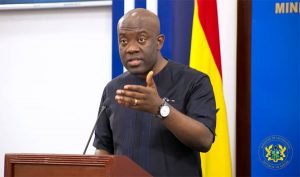The US will attempt to re-assert its global leadership on climate change as President Joe Biden hosts 40 leaders at a virtual summit in the White House.
It’s expected that the US will unveil an updated carbon pledge that will see its emissions nearly halved by 2030.
Ahead of the meeting, officials urged greater ambition on countries perceived as laggards on climate.
Referring to Australia, an official said “there would have to be a shift” in their approach. President Biden has made climate change a key focus in the early days of his administration.
As well as re-joining the Paris climate agreement on his first day in office, he announced early on that he would gather around 40 world leaders for a global summit on Earth Day – 22 April.
UK Prime Minister Boris Johnson will attend the summit, and is expected to tell leaders that 2021 is the year countries need to “get serious” about tackling climate change.
The UK is hosting the crucial COP 26 summit in November this year. Held in Glasgow, it will aim to galvanize action on keeping the global temperature rise this century to less than 1.5C.
China’s President Xi Jinping will also be among those attending.
Despite serious tensions between the two countries on a host of issues, both sides seem keen to keep climate change separate from these disputes. Last weekend, the two countries issued a joint statement saying they would tackle climate “with the seriousness and urgency it demands”.
Speaking ahead of the meeting, a senior Biden administration official spoke warmly about the potential for co-operation.
“It’s quite clear that there is a distinctly shared level of ambition. Both countries see this as a crisis. Both countries see the need for action in the 2020s. Both countries see the need to work towards holding the increase in global temperatures to 1.5C,” he said.
“We certainly hope that President Xi will come to the meeting, and further elaborate on some of the additional efforts that China would choose to make. But I think we’ve got a very strong basis in the joint statement that the two countries made about the directions they seem to be moving.”
But for other countries who have been slow to embrace action on climate change, the Biden team were less effusive.
Both Brazil and Australia’s skeptical approach to the issue had found favour in the Trump White House. That’s no longer the case.
“At the moment, I think that our colleagues in Australia recognize that there’s going to have to be a shift,” one official said.
“It’s insufficient to follow the existing trajectory, and hope that they will be on a course to deep decarbonization, and getting to net zero emissions by mid-century.”
Speaking about Brazil, the same official said: “The expectation for all countries is that the ambition has to be increased immediately.”
The UK is among the countries that have been keen to show their ambition ahead of the meeting. Earlier in the week, the prime minister announced a “world-leading” target for the UK to cut emissions by 78% on 1990 levels by 2035.
Boris Johnson is expected to tell the meeting: “The UK has shown that it’s possible to slash emissions while growing the economy, which makes the question of reaching net zero not so much technical as political.
“If we actually want to stop climate change, then this must be the year in which we get serious about doing so.
“Because the 2020s will be remembered either as the decade in which world leaders united to turn the tide, or as a failure.”
The US is also talking strongly about its ambition, but the proof of change for many observers will be in their new carbon-cutting pledge for 2030, which they are expected to announce at the summit.
This will require some clever footwork from the US. They will have to go for a figure that is scientifically credible but also politically achievable.
While the Democrats have a majority in the House of Representatives, the Senate is essentially deadlocked, making the passage of new climate legislation rather tricky.
“It seems to me that President Biden is in a bit of a bind, and he has to deal with the Congress that he has,” said Samantha Gross from the Brookings Institution.
“But I believe that Congress, particularly the Republicans, haven’t really kept up with increasing concern among the American public about climate.”
For some in the international community, even the mooted 50% cut in emissions won’t be going far enough.
“The US should cut at least 55% from 2005 levels by 2030 to inspire others to raise their ambitions,” said Quamrul Chowdhury, from Bangladesh and a climate negotiator for the Least Developed countries group.
“Mitigation is the best adaptation and major economies must cutback emissions quickly and steeply.”
The US pledge will undoubtedly be the headline, whatever its size – but there are also expected to be new steps announced by a number of countries.
“The three that I think are most likely beside the US to step up at this summit are Canada, Japan and South Korea,” said Helen Mountford from the World Resources Institute (WRI).
“China… would be fantastic, but I think [we] quite likely might wait longer, I wouldn’t expect it at this time.”
She added: “India is a real question mark, but whether they’re going to announce either a net zero target or enhanced plan, I would say there’s less of a chance of that.”
For those who were involved in the negotiations that led to the Paris agreement in 2015, the key thing this week is not to derail the discussions at the first hurdle.
This is the first big climate meeting of a critical year that will culminate in a gathering of around 200 world leaders in Glasgow in November at COP26.
“I think that for the US leaders summit to be a success, we need to have the 40 leaders present and expressing their willingness to reach strong agreement by Glasgow,” said Remy Rioux, who was a negotiator for France during the Paris talks.
“And also for the US to demonstrate that they are back, and that they are back as convincingly and strongly as possible.”







